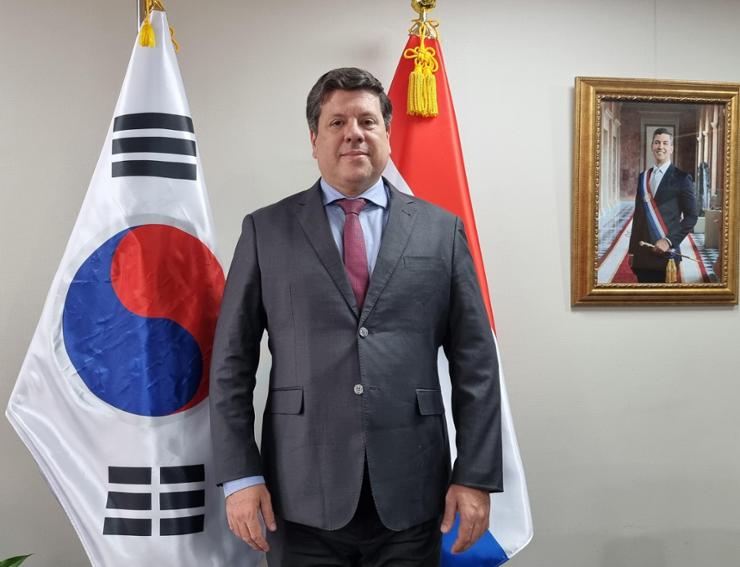Paraguayan Minister of Industry and Trade Javier Giménez García de Zuniga poses for a picture before an interview with The Korea Times at the Embassy of Paraguay in Seoul, Friday. Korea Times photo by Kim Hyun-bin
‘Korea serves as a model for economic development’
By Kim Hyun-bin
Paraguayan Minister of Industry and Trade Javier Giménez García de Zuniga said the signing of the Trade and Investment Promotion Framework (TIPF) with Korea on Friday will become the backbone of strengthened cooperation in manufacturing, energy and trade. He noted that the primary purpose of his visit to Seoul was to sign the TIPF.
“The framework is designed to deepen our cooperation with Korea, particularly in manufacturing and trade,” he said Friday in an interview with The Korea Times at the Embassy of Paraguay in Seoul.
The agreement is expected to attract additional Korean companies to Paraguay, leveraging the country’s strategic location in South America.
“Paraguay’s central location allows for efficient distribution to neighboring markets. We have a young population, abundant clean energy and key infrastructure that positions us as a logistical hub for South America,” Giménez García said.
Looking ahead, the minister said that after the signing of the framework, the next steps involve inviting Korean investors to Paraguay.
“We are extending an invitation to the Korean minister of trade, industry and energy to attend our energy week in October. We also plan to work closely with the Paraguayan Embassy in Korea to promote our country’s investment opportunities,” he said.
Korea and Paraguay have not signed a free trade agreement. But Korea exports approximately $20 million worth of goods to Paraguay each year, including automobiles and electronics. Giménez García expressed a desire to increase this trade volume.
“We want to engage with major Korean conglomerates like Hyundai and Kia to increase trade and investments,” he said.
To attract Korean investors, Paraguay offers several incentives, including a low corporate tax rate of 10 percent and various laws designed to support industrial growth.
“Our tax incentives and special laws make Paraguay an attractive destination for investments,” Giménez García said. “We are committed to maintaining a competitive business environment to foster economic growth.”
The minister acknowledged that while Paraguay has a strong trade relationship with Korea, there are challenges. One significant barrier is the high tariff on Paraguayan meat exports to Korea.
“We are working to reduce these tariffs and are awaiting the Korean authorities to conduct inspections to certify our slaughterhouses,” he said. “Our beef and pork are of high quality, and we believe they can compete well in the Korean market.”

Itaipu Binacional, a huge hydroelectric dam on the Paraná River between Brazil and Paraguay. Courtesy of Embassy of Paraguay in Seoul
Economic model
Addressing the current state of economic relations, Giménez García described them as stable with substantial potential for growth.
“Korea serves as a model for economic development, and we see many lessons to learn from their success,” he said. “Paraguay aims to emulate Korea’s approach to education and economic development to advance our own economy.”
The minister also emphasized the significant strides Korea has made over the past 75 years, underscoring the stark contrast between the economic trajectories of Korea and Paraguay since 1950.
“In the year 1950, Korea and Paraguay were on the same level of GDP,” he said. “Somehow, in these seventy-five years, Korea has grown to be one of the top economies in the world with around a $1.7 trillion economy. Meanwhile, Paraguay has remained largely an exporter of agricultural products, similar to Korea’s status in 1950.”
The minister asked, “What happened? Why did Korea grow like this and Paraguay stayed more or less on the same level of economic development?”
Giménez García pointed to several key factors that contributed to Korea’s success, notably its investments in education.
“A number of things happened, a number of things Korea did correctly that we need to copy, that we need to imitate,” he said. “Good examples need to be imitated, need to be copied. And this is why we’re here — to learn from Korea’s experience.”
He highlighted Korea’s strategic focus on education as a crucial element of its economic transformation.
“The main step that Korea took over these 75 years was especially all of the things related to education,” Giménez García said. “Korea invested a lot in the education of its people, and this is why now we have the best quality manufactured items coming from Korea, not only in cars but also in technology, the shipping industry and a number of other sectors.”


